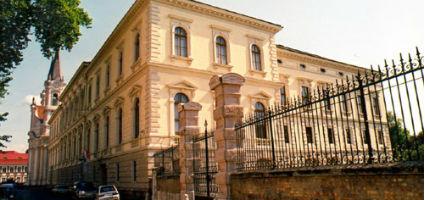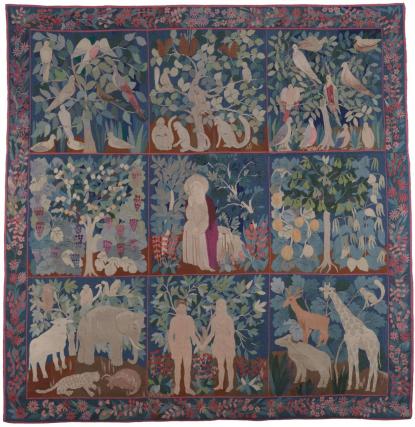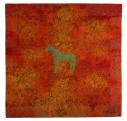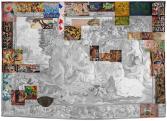2024. May 6. Monday
Christian Museum - Esztergom
 |
Address: 2500, Esztergom Mindszenty tér 2.
Phone number: (33) 413-880
E-mail: keresztenymuzeum@vnet.hu
Opening hours: Wed-Sun 10-17
|
The exhibition has closed for visitors.
2014.05.10. - 2014.08.24.
Museum tickets, service costs:
|
Ticket for adults
|
800 HUF
|
|
|
Ticket for students
|
400 HUF
|
|
|
Ticket for pensioners
(Hungarian)
|
400 HUF
|
|
|
Group guide
|
2500 HUF
|
/ group
|
|
Group guide
|
5000 HUF
|
/ group
|
Esztergom’s Christian Museum holds a larger number of late medieval and early modern age wall tapestries than any institution in Hungary apart from the Museum of Applied Arts in Budapest. The Christian Museum’s close links to the genre, which looks back on substantial traditions in Hungary also, are shown by the many tapestry-related events it has staged over the last decade. The present exhibition entitled ‘Historical and Contemporary Tapestries in Hungary’ is the latest of these. Staged in co-operation with the Museum of Applied Arts and the Ildikó Dobrányi Foundation (named after the well-known tapestry artist and art organiser who died in 2007), it conveys the past and present of European woven tapestry, illuminating the connections also.

The first section of the exhibition is entitled ‘Flemish Tapestries with Biblical and Mythological Themes from the Museum of Applied Arts and the Christian Museum’. In it, one of the genre’s most significant traditions – the Flemish – is represented by Oudenaarde and Tournai tapestries kept at the Christian Museum and by the 18th-century Brussels tapestry ‘Mercury Hands Over the Infant Bacchus to the Nymphs’, a work preserved at the Museum of Applied Arts. To this last-mentioned tapestry is connected the Web of Europe assemblage of works. In contrast to the collective tradition in tapestry art which rests on co-operation between designers, cartoon-makers, and weavers, this assemblage denotes the recent, individual, independent strand of the genre and leads into the exhibition’s second section:
‘Autonomous Tapestry Art’. This second section presents the sovereign tradition associated in Hungary with Noémi Ferenczy first and foremost. An outstanding figure in the history of art in Hungary, Noémi Ferenczy was not just an artist, but also a teacher who established her own school. In 1951, she set up the Department of Tapestry at the Academy of Applied Arts, the legal predecessor of today’s Moholy-Nagy University of Art and Design, running it in conformity with her own approach. A student of Ferenczy’s, Gizella Solti graduated from the Department of Tapestry in 1955. Later on, she was a member of the ‘Great Generation’ which, in the 1970s, brought about the golden age of Hungarian textile art. As well as tapestries by Noémi Ferenczy and Gizella Solti and material shown at the 6th Szombathely Biennale, which was billed as ‘±Gobelin’ and which represented a turning point in the history of autonomous tapestry art in Hungary, the second section presents Hungarian works awarded prizes at international competitions held around the year 2000. However, this period witnessed not only the weaving of autonomous tapestries, but also the production of collaborative works reviving the collective traditions of the genre. Of these collaborative pieces, the tapestries St. Stephen and His Work and Lights of Europe are both on display at the Christian Museum’s exhibition entitled Historical and Contemporary Tapestries in Hungary.

The first section of the exhibition is entitled ‘Flemish Tapestries with Biblical and Mythological Themes from the Museum of Applied Arts and the Christian Museum’. In it, one of the genre’s most significant traditions – the Flemish – is represented by Oudenaarde and Tournai tapestries kept at the Christian Museum and by the 18th-century Brussels tapestry ‘Mercury Hands Over the Infant Bacchus to the Nymphs’, a work preserved at the Museum of Applied Arts. To this last-mentioned tapestry is connected the Web of Europe assemblage of works. In contrast to the collective tradition in tapestry art which rests on co-operation between designers, cartoon-makers, and weavers, this assemblage denotes the recent, individual, independent strand of the genre and leads into the exhibition’s second section:
‘Autonomous Tapestry Art’. This second section presents the sovereign tradition associated in Hungary with Noémi Ferenczy first and foremost. An outstanding figure in the history of art in Hungary, Noémi Ferenczy was not just an artist, but also a teacher who established her own school. In 1951, she set up the Department of Tapestry at the Academy of Applied Arts, the legal predecessor of today’s Moholy-Nagy University of Art and Design, running it in conformity with her own approach. A student of Ferenczy’s, Gizella Solti graduated from the Department of Tapestry in 1955. Later on, she was a member of the ‘Great Generation’ which, in the 1970s, brought about the golden age of Hungarian textile art. As well as tapestries by Noémi Ferenczy and Gizella Solti and material shown at the 6th Szombathely Biennale, which was billed as ‘±Gobelin’ and which represented a turning point in the history of autonomous tapestry art in Hungary, the second section presents Hungarian works awarded prizes at international competitions held around the year 2000. However, this period witnessed not only the weaving of autonomous tapestries, but also the production of collaborative works reviving the collective traditions of the genre. Of these collaborative pieces, the tapestries St. Stephen and His Work and Lights of Europe are both on display at the Christian Museum’s exhibition entitled Historical and Contemporary Tapestries in Hungary.



